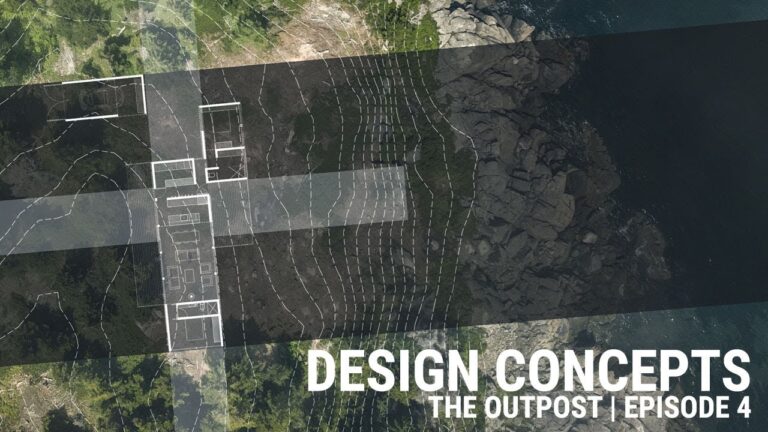
I’m sketching design concepts for the Outpost project for our upcoming schematic design meeting. Join me in the studio as I turn a rough concept into a digital model and schematic floor plans. This is the process I use for all my work. It begins as a mess and I iterate until it gets stronger and more coherent. The goal of the schematic design meeting is to settle on the architectural concept, choose a location on the site to locate the home and ideally a floor plan to move forward with.
I’ve been thinking about this project and working on it in my sketchbook for a while, but now I have to make them real. The abstract ideas are overlaid on the site plan and I begin to react to the topography and create places and space in and around the home. Along with the site plan, I gather the building program – the list of spaces we need to include – a scale, some tracing paper and pens.
The architectural design concept is heavily influenced by the site and this remote place. We know we want to knit the home closely to the landform and given there’s a lot of elevation change and we have limited access to concrete and fill material we’ll be creating platforms and using decks to transition between the land and the home. By dividing the program spaces up into tiny cabins I can position each to react to the appropriate site force or feature that’s nearby. I know from meeting with local contractors that it’s difficult to bring concrete and fill material to the island so what I might normally do on the mainland to fit a building to the landform is going to be costly. So, I don’t really have the option to do much site work or to shape the site in any meaningful way so this is another reason for adopting this kind of a strategy. Each cabin will have to sit lightly on the land without access to a poured in place concrete foundation so we’ll likely be using piers.
I block out the spaces on the site plan very roughly at first. The early sketches are more diagrams than floor plans. I locate the major spaces and then sketch on top of the diagram adding more and more detail: doors, windows, hallways, fixtures, furniture and stairs. Each layer builds in more information. I’ll sketch the floor plans at a low level of resolution and then begin looking at the design in three dimensions.
For this meeting I’m building digital models in SketchUp as I’ll be traveling to the island for the meeting. Physical models will come later, but in both cases, models help me to study the spatial relationships more closely. The information I learn building the models feeds directly back in to the design of the plans. This back and forth is a typical part of the an architect’s design process.
Whether we’re designing a small outpost like this or an airport, architects follow similar steps. It’s an iterative process, you move between plan and section and model and each step informs the next.
As an architect you process a lot of information, evaluate all the constraints and opportunities and try to make something beautiful out it all. I think it’s hard to do much better than the natural environment surrounding this home – what’s there already – so really my job is to respect it by doing as little as possible.
My sincere thanks to my clients for their willingness to share their project and process publicly. Architecture isn’t possible without great clients.
// GEAR I USE //
CAD DRAWING TEMPLATE:
* Download here: http://thirtybyforty.com/autocad-template
ARCHITECT’S TOOLKIT:
* Architect + Entrepreneur Startup Toolkit: http://thirtybyforty.com/SPL
ARCHITECTURE ESSENTIAL TOOLS:
* http://thirtybyforty.com/archi-gear
PHOTOGRAPHY GEAR:
*http://thirtybyforty.com/my-photo-gear
MUSIC I USE:
* http://thirtybyforty.com/music
MOTION GRAPHICS:
*http://thirtybyforty.com/mvfx
#architecture #designtutorial #architecturetutorial
source